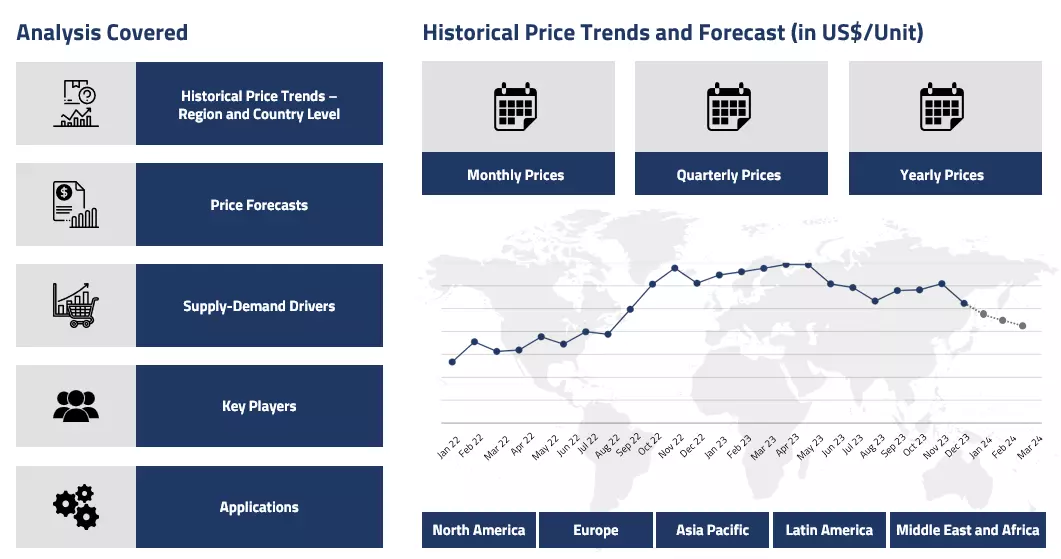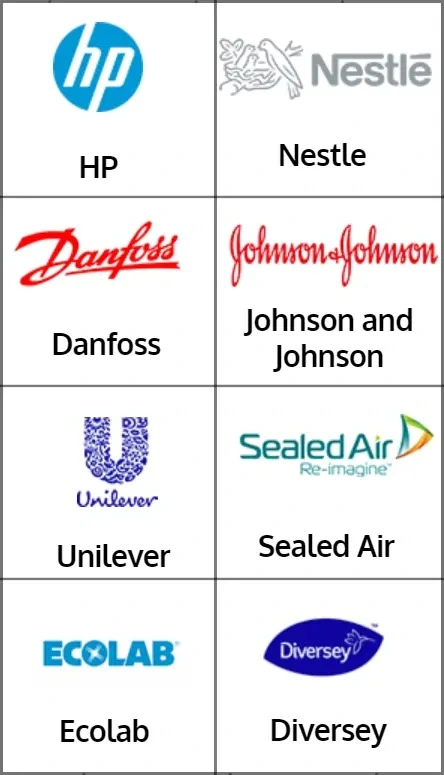Product
Instant Noodles Price Trend and Forecast
Instant Noodles Price Trend and Forecast
Instant Noodles Regional Price Overview
Get the latest insights on price movement and trend analysis of Instant Noodles in different regions across the world (Asia, Europe, North America, Latin America, and the Middle East & Africa).
Instant Noodles Price Trend for the First Half of 2025
In the first half of 2025, the price of instant noodles in South Korea steadily increased, reflecting broader inflationary pressures across the food sector. Major instant noodle manufacturers raised their prices multiple times, driven mainly by rising costs of raw materials, logistics, and labor. This marked a noticeable shift after a period of relative price stability, as companies responded to weakened government price control efforts following political changes earlier in the year.
Instant Noodles Price Chart

Please Login or Subscribe to Access the Instant Noodles Price Chart Data
Processed foods, including instant noodles, saw sharper price increases compared to other grocery items, with many popular brands pushing prices closer to or above key psychological thresholds. Consumer feedback indicated growing frustration as what was once considered a budget-friendly meal became less affordable. This trend was consistent with overall rising food costs, including meat and eggs, further straining household budgets.
Despite some easing in global commodity prices, domestic factors such as currency fluctuations and supply chain challenges kept production costs high. The food industry’s decision to pass these costs onto consumers was seen as a response to both economic realities and a temporary lack of government price intervention. Retailers and consumers alike noted that instant noodles, once a staple affordable meal, were becoming a symbol of broader inflation worries.
Analyst Insight
According to Procurement Resource, Instant Noodles prices are expected to remain elevated through the coming months as input costs persist, though gradual stabilization may occur if inflationary pressures ease and policy measures strengthen.
Instant Noodle Price Trend for the Second Half of 2024
In the second half of 2024, instant noodle prices in the U.S. showed a steady upward trend. This rise was mainly driven by a continued surge in demand that started during the pandemic and hasn’t slowed down. As more consumers turned to quick, affordable meals, brands like Nissin, Maruchan, and Samyang saw increased pressure to keep up with both demand and rising production costs.
Inflation played a big role in pricing shifts. As costs for ingredients, packaging, and shipping climbed, manufacturers adjusted their suggested prices. Although instant noodles remained a budget-friendly option, shoppers started to feel the pinch as promotions and discounts became less frequent. Nissin, one of the industry leaders, even came under investigation in Japan for trying to control retail prices, suggesting a broader industry effort to protect margins amid inflationary pressure.
At the same time, rising popularity of premium and spicy noodle varieties from Korean brands like Samyang and Nongshim also contributed to the shift. These products typically cost more and further nudged the average price higher.
While noodles remained an accessible meal choice, price sensitivity increased. Consumers like gamers, students, and busy parents still bought them regularly but the value-for-money factor was now more carefully considered than before.
Analyst Insight
According to Procurement Resource, Instant Noodles prices are expected to remain elevated into early 2025, though further hikes may slow as competition intensifies and inflation stabilizes.
Price Trend of Instant Noodles for the First Half of 2024
In the first half of 2024, instant noodles in China experienced a noticeable price increase, reflecting the broader inflationary pressure across the country. Once considered an ultra-affordable staple for low-income households and budget-conscious consumers, even this basic comfort food became more expensive.
Major manufacturers like Master Kong raised retail prices, and portion sizes for accompanying items like pickled mustard tuber shrank, contributing to a higher overall cost for what was jokingly called the "poor man's set meal".
This upward trend was part of a broader economic strain. Rising costs of raw materials such as flour, pork, and coriander pushed up production expenses, impacting both packaged noodle products and street food vendors alike. While some companies benefited from lower flour prices later in the period, the savings did not always translate to the consumer, as brands aimed to protect or grow profit margins.
Consumer behaviour also shifted. Many people who once belonged to the upper middle class started switching to instant noodles as their primary meal option due to failed investments and mounting debt. At the same time, families began cooking at home more often to cut costs, signalling reduced demand for convenience-based food services.
Analyst Insight
According to Procurement Resource, if inflationary pressures persist and consumer confidence remains weak, the trend of rising prices and shrinking portions could continue into H2’24.
Instant Noodles Price Trend for the Second Half of 2023
During the second half of 2023, instant noodle prices showed a steady upward trend globally. This rise was largely driven by inflation and increased production costs, particularly for ingredients like wheat and packaging materials.
In Japan and other key markets, major manufacturers, including Nissin Foods, responded by raising prices by around 10% for two consecutive years. These hikes reflected not only raw material costs but also growing logistical and operational expenses.
Despite the price increases, demand remained strong. Economic pressures worldwide pushed many middle-class consumers, especially in countries without a strong noodle-eating tradition like the U.S. and Mexico, to turn to instant noodles as a cheap and convenient food option. In fact, global consumption hit a record 121.2 billion servings in 2022 and remained high into 2023, showing that consumers were willing to absorb small price increases for affordable meal solutions.
Manufacturers like Nissin adapted by diversifying their product lines and focusing on premium options, such as Stir Fry and Fire Wok variants, which allowed them to justify higher prices.
In Southeast Asia, the brand experimented with high-end noodle restaurants, signalling a shift toward brand expansion beyond supermarkets. Additionally, production was optimized through international restructuring like Nissin’s China unit taking over operations in Vietnam aiming for cost control and regional supply chain efficiency.
Analyst Insight
According to Procurement Resource, Instant Noodles prices may continue to rise moderately in 2024, but strong global demand and expansion into premium and regional markets should support steady growth for the instant noodle industry.
Instant Noodles Price Trend for the First Half of 2023
Instant noodles have seen a striking rise in consumption over the past few years. The simple reason is their affordability. With the inflation shooting through the roof, the general commodity prices rose. From fruits, vegetables, and meat to flour, bread, etc., everything saw a rise in prices.
The adverse weather conditions hampered the agricultural yields, fuelling the price hike even more. Instant noodles also could not resist the price hike since the feedstock flour prices rose. And despite the price hikes, instant noodles were still one of the more affordable food options.
So, to compensate for the revenue losses in other food options, the food companies raised the prices for Instant noodles since they were still getting off the shelves much quicker. An estimated 10% rise was seen in Instant noodles prices.
Analyst Insight
According to Procurement Resource, given the demand scenario for Instant noodles, the prices are likely to rise even further in the coming months.
Instant Noodles Price Trend for the Second Half of 2022
The prices of instant noodles saw an uprising trend after a long period of stagnancy, especially in the Thai market. The Ukraine crisis, along with drought and floods in the region drove up the transport, energy, and wheat expense rates, which in turn resulted in the upward trajectory in the prices throughout the Asia-Pacific region.
The producers in some regions faced reduced profit margins due to high production costs and thus, were forced to increase the prices of instant noodles. The uprising price trend was also in order with the strong demand from the low-income households that employ instant noodles as a staple. Thus, the synergistic effect of high demand, strong supply, and increasing cost of production, the price trend for instant noodles significantly improved globally.
Analyst Insight
According to Procurement Resource, the prices of instant noodles are likely to increase in the upcoming quarter. As the global market is expected to showcase high demand and a rise in production costs will further drive the price trend for instant noodles.
Instant Noodles Price Trend For the First Half of 2022
According to the World Economic Forum, the prices of cereals ( wheat, barley, and other grains) have increased by 89% since September 2019. With Ukraine being a major supplier of wheat, the current geopolitical crisis has taken a toll on wheat prices globally. With floods in the major Chinese wheat-producing belt, wheat prices surged throughout the Asian market. The supply shortages amid the inflationary pricing caused wheat prices to rise by 30% in China, averaging 3200 RMB/MT.
The rising wheat prices caused the instant noodles companies to raise their prices to safeguard their profit margins. Nissin Foods, the originator of instant noodles, raised its prices after 11 years. The South Korean Shin Ramen registered a hike of 11%in their instant noodles’ prices. The ex-factory prices of Tingyu (prominent Chinese manufacturer) hiked the prices by 10% during the said period. Hence, the price trend for instant noodles soared globally owing to the high raw material costs, labour, and sourcing expenses.
Procurement Resource provides latest prices of Instant Noodles. Each price database is tied to a user-friendly graphing tool dating back to 2014, which provides a range of functionalities: configuration of price series over user defined time period; comparison of product movements across countries; customisation of price currencies and unit; extraction of price data as excel files to be used offline.
About Instant Noodles
Instant Noodles are dried or precooked noodles that are often sold with sachets of flavouring including seasoning oil. Dried noodles are generally eaten after being cooked or soaked in boiling water, while precooked or instant noodles can be reheated or eaten straight from the packet.
Instant Noodles Product Details
| Report Features | Details |
| Product Name | Instant Noodles |
| Synonyms | Instant ramen |
| Industrial Uses | Noodle soup, Noodle |
| Supplier Database | Nestlé SA, Ajinomoto Co., Inc, Unilever, Capital Foods Pvt. Ltd, ITC Limited |
| Region/Countries Covered | Asia Pacific: China, India, Indonesia, Pakistan, Bangladesh, Japan, Philippines, Vietnam, Iran, Thailand, South Korea, Iraq, Saudi Arabia, Malaysia, Nepal, Taiwan, Sri Lanka, UAE, Israel, Hongkong, Singapore, Oman, Kuwait, Qatar, Australia, and New Zealand Europe: Germany, France, United Kingdom, Italy, Spain, Russia, Turkey, Netherlands, Poland, Sweden, Belgium, Austria, Ireland Switzerland, Norway, Denmark, Romania, Finland, Czech Republic, Portugal and Greece North America: United States and Canada Latin America: Brazil, Mexico, Argentina, Columbia, Chile, Ecuador, and Peru Africa: South Africa, Nigeria, Egypt, Algeria, Morocco |
| Currency | US$ (Data can also be provided in local currency) |
| Supplier Database Availability | Yes |
| Customization Scope | The report can be customized as per the requirements of the customer |
| Post-Sale Analyst Support | 360-degree analyst support after report delivery |
Note: Our supplier search experts can assist your procurement teams in compiling and validating a list of suppliers indicating they have products, services, and capabilities that meet your company's needs.
Instant Noodles Production Processes
- Production of Instant Noodles via Dehydration Process
To produce Instant Noodles, all the ingredients are first mixed in the dough, then it is rolled out, cut into noodles, steamed, dried, fried for a minute or two for dehydration, cooled, and then finally packed into the individual units.
Methodology
The displayed pricing data is derived through weighted average purchase price, including contract and spot transactions at the specified locations unless otherwise stated. The information provided comes from the compilation and processing of commercial data officially reported for each nation (i.e. government agencies, external trade bodies, and industry publications).
Assistance from Experts
Procurement Resource is a one-stop solution for businesses aiming at the best industry insights and market evaluation in the arena of procurement. Our team of market leaders covers all the facets of procurement strategies with its holistic industry reports, extensive production cost and pre-feasibility insights, and price trends dynamics impacting the cost trajectories of the plethora of products encompassing various industries. With the best analysis of the market trends and comprehensive consulting in light of the best strategic footstep, Procurement Resource got all that it takes.
Client's Satisfaction
Procurement Resource has made a mark for itself in terms of its rigorous assistance to its clientele. Our experienced panel of experts leave no stone unturned in ensuring the expertise at every step of our clients' strategic procurement journey. Our prompt assistance, prudential analysis, and pragmatic tactics considering the best procurement move for industries are all that sets us apart. We at Procurement Resource value our clients, which our clients vouch for.
Assured Quality
Expertise, judiciousness, and expedience are the crucial aspects of our modus operandi at Procurement Resource. Quality is non-negotiable, and we don't compromise on that. Our best-in-class solutions, elaborative consulting substantiated by exhaustive evaluation, and fool-proof reports have led us to come this far, making us the ‘numero uno' in the domain of procurement. Be it exclusive qualitative research or assiduous quantitative research methodologies, our high quality of work is what our clients swear by.
Table Of Contents
Our Clients

Get in Touch With Us

UNITED STATES
Phone:+1 307 363 1045

INDIA
Phone: +91 8850629517

UNITED KINGDOM
Phone: +44 7537 171117
Email: sales@procurementresource.com

